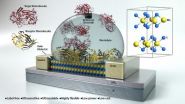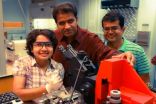(Press-News.org) Move over, graphene. An atomically thin, two-dimensional, ultrasensitive semiconductor material for biosensing developed by researchers at UC Santa Barbara promises to push the boundaries of biosensing technology in many fields, from health care to environmental protection to forensic industries.
Based on molybdenum disulfide or molybdenite (MoS2), the biosensor material — used commonly as a dry lubricant — surpasses graphene's already high sensitivity, offers better scalability and lends itself to high-volume manufacturing. Results of the researchers' study have been published in ACS Nano.
"This invention has established the foundation for a new generation of ultrasensitive and low-cost biosensors that can eventually allow single-molecule detection — the holy grail of diagnostics and bioengineering research," said Samir Mitragotri, co-author and professor of chemical engineering and director of the Center for Bioengineering at UCSB. "Detection and diagnostics are a key area of bioengineering research at UCSB and this study represents an excellent example of UCSB's multifaceted competencies in this exciting field."
The key, according to UCSB professor of electrical and computer engineering Kaustav Banerjee, who led this research, is MoS2's band gap, the characteristic of a material that determines its electrical conductivity.
Semiconductor materials have a small but nonzero band gap and can be switched between conductive and insulated states controllably. The larger the band gap, the better its ability to switch states and to insulate leakage current in an insulated state. MoS2's wide band gap allows current to travel but also prevents leakage and results in more sensitive and accurate readings.
While graphene has attracted wide interest as a biosensor due to its two-dimensional nature that allows excellent electrostatic control of the transistor channel by the gate, and high surface-to-volume ratio, the sensitivity of a graphene field-effect transistor (FET) biosensor is fundamentally restricted by the zero band gap of graphene that results in increased leakage current, leading to reduced sensitivity, explained Banerjee, who is also the director of the Nanoelectronics Research Lab at UCSB.
Graphene has been used, among other things, to design FETs — devices that regulate the flow of electrons through a channel via a vertical electric field directed into the channel by a terminal called a "gate." In digital electronics, these transistors control the flow of electricity throughout an integrated circuit and allow for amplification and switching.
In the realm of biosensing, the physical gate is removed, and the current in the channel is modulated by the binding between embedded receptor molecules and the charged target biomolecules to which they are exposed. Graphene has received wide interest in the biosensing field and has been used to line the channel and act as a sensing element whose surface potential (or conductivity) can be modulated by the interaction (known as conjugation) between the receptor and target molecules that results in net accumulation of charges over the gate region.
However, said the research team, despite graphene's excellent characteristics, its performance is limited by its zero band gap. Electrons travel freely across a graphene FET — hence, it cannot be "switched off" — which in this case results in current leakages and higher potential for inaccuracies.
Much research in the graphene community has been devoted to compensating for this deficiency, either by patterning graphene to make nanoribbons or by introducing defects in the graphene layer — or using bilayer graphene stacked in a certain pattern that allows band gap opening upon application of a vertical electric field — for better control and detection of current.
Enter MoS2, a material already making waves in the semiconductor world for the similarities it shares with graphene, including its atomically thin hexagonal structure, and planar nature, as well as what it can do that graphene can't: act like a semiconductor.
"Monolayer or few-layer MoS2 have a key advantage over graphene for designing an FET biosensor: They have a relatively large and uniform band gap (1.2-1.8 eV, depending on the number of layers) that significantly reduces the leakage current and increases the abruptness of the turn-on behavior of the FETs, thereby increasing the sensitivity of the biosensor," said Banerjee.
Additionally, according to Deblina Sarkar, a PhD student in Banerjee's lab and the lead author of the article, two-dimensional MoS2 is relatively simple to manufacture.
"While one-dimensional materials such as carbon nanotubes and nanowires also allow excellent electrostatics and at the same time possess band gap, they are not suitable for low-cost mass production due to their process complexities," she said. "Moreover, the channel length of MoS2 FET biosensor can be scaled down to the dimensions similar to those of small biomolecules such as DNA or small proteins, still maintaining good electrostatics, which can lead to high sensitivity even for detection of single quanta of these biomolecular species," she added.
"In fact, atomically thin MoS2 provides the best of everything: great electrostatics due to their ultra-thin body, scalability (due to large band gap), as well as patternability due to their planar nature that is essential for high-volume manufacturing," said Banerjee.
The MoS2 biosensors demonstrated by the UCSB team have already provided ultrasensitive and specific protein sensing with a sensitivity of 196 even at 100 femtomolar (a billionth of a millionth of a mole) concentrations. This protein concentration is similar to one drop of milk dissolved in a hundred tons of water. An MoS2-based pH sensor achieving sensitivity as high as 713 for a pH change by one unit along with efficient operation over a wide pH range (3-9) is also demonstrated in the same work.
"This transformative technology enables highly specific, low-power, high-throughput physiological sensing that can be multiplexed to detect a number of significant, disease-specific factors in real time," commented Scott Hammond, executive director of UCSB's Translational Medicine Research Laboratories.
Biosensors based on conventional FETs have been gaining momentum as a viable technology for the medical, forensic and security industries since they are cost-effective compared to optical detection procedures. Such biosensors allow for scalability and label-free detection of biomolecules — removing the step and expense of labeling target molecules with florescent dye. "In essence," continued Hammond, "the promise of true evidence-based, personalized medicine is finally becoming reality."
"This demonstration is quite remarkable," said Andras Kis, professor at École Polytechnique Fédérale de Lausanne in Switzerland and a leading scientist in the field of 2D materials and devices. "At present, the scientific community worldwide is actively seeking practical applications of 2D semiconductor materials such as MoS2 nanosheets. Professor Banerjee and his team have identified a breakthrough application of these nanomaterials and provided new impetus for the development of low-power and low-cost ultrasensitive biosensors," continued Kis, who is not connected to the project.
INFORMATION:
Wei Liu and Xuejun Xie from UCSB's Department of Electrical and Computer Engineering and Aaron Anselmo from the Department of Chemical Engineering also conducted research for this study. Research on this project was supported by the National Science Foundation, the California NanoSystems Institute at UCSB and the Materials Research Laboratory at UCSB, a National Science Foundation MRSEC.
UCSB researchers develop ultra sensitive biosensor from molybdenite semiconductor
UC Santa Barbara researchers demonstrate atomically thin, ultrasensitive and scalable molybdenum disulfide field-effect transistor based biosensors and establish their potential for single-molecule detection
2014-09-04
ELSE PRESS RELEASES FROM THIS DATE:
A minimally invasive, high-performance intervention for staging lung cancer
2014-09-04
Endoscopic biopsy of lymph nodes between the two lungs (mediastinum) is a sensitive and accurate technique that can replace mediastinal surgery for staging lung cancer in patients with potentially resectable tumours. Such were the conclusions of a prospective controlled trial conducted under Dr. Moishe Liberman, a researcher at the CHUM Research Centre (CRCHUM) and an Associate Professor at the Université de Montréal. Moreover, the study showed that it is not necessary to perform surgery to confirm negative results obtained through the endoscopic approach during the pre-operative ...
Breakthrough study identifies genetic link between the circadian clock and seasonal timing
2014-09-04
Researchers from the University of Leicester have for the first time provided experimental evidence for a genetic link between two major timing mechanisms, the circadian clock and the seasonal timer.
New research from the Tauber laboratory at the University of Leicester, which will be published in the academic journal PLOS Genetics on 4 September, has corroborated previous observations that flies developed under short days become significantly more cold-resistant compared with flies raised in long-days, suggesting that this response can be used to study seasonal photoperiodic ...
The yin and yang of overcoming cocaine addiction
2014-09-04
PITTSBURGH—Yaoying Ma says that biology, by nature, has a yin and a yang—a push and a pull.
Addiction, particularly relapse, she finds, is no exception.
Ma is a research associate in the lab of Yan Dong, assistant professor of neuroscience in the University of Pittsburgh's Kenneth P. Dietrich School of Arts and Sciences. She is the lead author of a paper published online today in the journal Neuron that posits that it may be possible to ramp up an intrinsic anti-addiction response as a means to fight cocaine relapse and keep the wolves of relapse at bay.
This paper ...
A metallic alloy that is tough and ductile at cryogenic temperatures
2014-09-04
A new concept in metallic alloy design – called "high-entropy alloys" - has yielded a multiple-element material that not only tests out as one of the toughest on record, but, unlike most materials, the toughness as well as the strength and ductility of this alloy actually improves at cryogenic temperatures. This multi-element alloy was synthesized and tested through a collaboration of researchers at the U.S. Department of Energy (DOE)'s Lawrence Berkeley and Oak Ridge National Laboratories (Berkeley Lab and ORNL).
"We examined CrMnFeCoNi, a high-entropy alloy that contains ...
Rosetta-Alice spectrograph obtains first far ultraviolet spectra of a cometary surface
2014-09-04
Boulder, Colo. — Sept. 4, 2014 — NASA's Alice ultraviolet (UV) spectrograph aboard the European Space Agency's Rosetta comet orbiter has delivered its first scientific discoveries. Rosetta, in orbit around comet 67P/Churyumov-Gerasimenko, is the first spacecraft to study a comet up close.
As Alice began mapping the comet's surface last month, it made the first far ultraviolet spectra of a cometary surface. From these data, the Alice team discovered that the comet is unusually dark at ultraviolet wavelengths and that the comet's surface — so far — shows no large water-ice ...
Avian influenza virus isolated in harbor seals poses a threat to humans
2014-09-04
(MEMPHIS, Tenn. – September 4, 2014) A study led by St. Jude Children's Research Hospital scientists found the avian influenza A H3N8 virus that killed harbor seals along the New England coast can spread through respiratory droplets and poses a threat to humans. The research appears in the current issue of the scientific journal Nature Communications.
The avian H3N8 virus was isolated by scientists investigating the 2011 deaths of more than 160 harbor seals. Researchers discovered the virus had naturally acquired mutations in a key protein that previous laboratory research ...
2-D or 3-D? That is the question
2014-09-04
The increased visual realism of 3-D films is believed to offer viewers a more vivid and lifelike experience—more thrilling and intense than 2-D because it more closely approximates real life. However, psychology researchers at the University of Utah, among those who use film clips routinely in the lab to study patients' emotional conditions, have found that there is no significant difference between the two formats. The results were published recently in PLOS ONE.
The study aimed to validate the effectiveness of 3-D film, a newer technology, as compared to 2-D film that ...
Team identifies important regulators of immune cell response
2014-09-04
JUPITER, FL, September 4, 2014 - In a collaborative study, scientists from the Florida campus of The Scripps Research Institute (TSRI) and the La Jolla Institute for Allergy and Immunology have developed a more effective method to determine how immune cells called T cells differentiate into specialized types of cells that help eradicate infected cells and assist other immune cells during infection.
The new approach, published recently by the journal Immunity, could help accelerate laboratory research and the development of potential therapeutics, including vaccines. The ...
Knowing how bacteria take out trash could lead to new antibiotics
2014-09-04
AMHERST, Mass. – A collaborative team of scientists including biochemist Peter Chien at the University of Massachusetts Amherst has reconstructed how bacteria tightly control their growth and division, a process known as the cell cycle, by specifically destroying key proteins through regulated protein degradation.
Regulated protein degradation uses specific enzymes called energy dependent proteases to selective destroy certain targets. Because regulated protein degradation is critical for bacterial virulence and invasion, understanding how these proteases function should ...
Reacting to personal setbacks: Do you bounce back or give up?
2014-09-04
Sometimes when people get upsetting news – such as a failing exam grade or a negative job review – they decide instantly to do better the next time. In other situations that are equally disappointing, the same people may feel inclined to just give up.
How can similar setbacks produce such different reactions? It may come down to how much control we feel we have over what happened, according to new research from Rutgers University-Newark.
The study, published in the journal Neuron, also finds that when these setbacks occur, the level of control we perceive may even determine ...
LAST 30 PRESS RELEASES:
Injectable breast ‘implant’ offers alternative to traditional surgeries
Neuroscientists devise formulas to measure multilingualism
New prostate cancer trial seeks to reduce toxicity without sacrificing efficacy
Geometry shapes life
A CRISPR screen reveals many previously unrecognized genes required for brain development and a new neurodevelopmental disorder
Hot flush treatment has anti-breast cancer activity, study finds
Securing AI systems against growing cybersecurity threats
Longest observation of an active solar region
Why nail-biting, procrastination and other self-sabotaging behaviors are rooted in survival instincts
Regional variations in mechanical properties of porcine leptomeninges
Artificial empathy in therapy and healthcare: advancements in interpersonal interaction technologies
Why some brains switch gears more efficiently than others
UVA’s Jundong Li wins ICDM’S 2025 Tao Li Award for data mining, machine learning
UVA’s low-power, high-performance computer power player Mircea Stan earns National Academy of Inventors fellowship
Not playing by the rules: USU researcher explores filamentous algae dynamics in rivers
Do our body clocks influence our risk of dementia?
Anthropologists offer new evidence of bipedalism in long-debated fossil discovery
Safer receipt paper from wood
Dosage-sensitive genes suggest no whole-genome duplications in ancestral angiosperm
First ancient human herpesvirus genomes document their deep history with humans
Why Some Bacteria Survive Antibiotics and How to Stop Them - New study reveals that bacteria can survive antibiotic treatment through two fundamentally different “shutdown modes”
UCLA study links scar healing to dangerous placenta condition
CHANGE-seq-BE finds off-target changes in the genome from base editors
The Journal of Nuclear Medicine Ahead-of-Print Tip Sheet: January 2, 2026
Delayed or absent first dose of measles, mumps, and rubella vaccination
Trends in US preterm birth rates by household income and race and ethnicity
Study identifies potential biomarker linked to progression and brain inflammation in multiple sclerosis
Many mothers in Norway do not show up for postnatal check-ups
Researchers want to find out why quick clay is so unstable
Superradiant spins show teamwork at the quantum scale
[Press-News.org] UCSB researchers develop ultra sensitive biosensor from molybdenite semiconductorUC Santa Barbara researchers demonstrate atomically thin, ultrasensitive and scalable molybdenum disulfide field-effect transistor based biosensors and establish their potential for single-molecule detection






